Stilsat-1: A Russian-owned and Chinese-built satellite watching Ukraine (part 1)by Bart Hendrickx
|
| The Russians call it Stilsat-1, but no satellite by that name has been officially announced as such after launch or registered with the United Nations. The reason is that it was built and launched by China and turned over to Russia on a turnkey basis. |
Stilsoft became involved in the development of remote sensing satellites in early 2022. It set up a specialized space design bureau in February of that year and, three months later, established a subsidiary called Stilspace. [5] Stilsoft bears responsibility for developing the satellites, the ground support network, and associated software. Stilspace is responsible for operating the satellite constellation and processing the remote sensing data.
Stilsoft has not really made a secret of the fact that Stilsat is primarily intended for military purposes. During a presentation in November 2023, Yuri Stoyanov called it a space-based extension of the work Stilsoft had been doing for the security agencies both on land and in the air. [6] The fact that the project started at the time of Russia’s large-scale invasion of Ukraine in February 2022 was not a coincidence.
During another presentation in October 2023, Stilspace’s executive director, Anton Burmak, seemingly deviated from his script by briefly expanding on the motives for acquiring a satellite from China. He said that Stilsoft had been discussing a satellite project with Russia’s security agencies before the so-called “special military operation,” but that plans had to be accelerated when it eventually got underway. Since it was impossible to build a high-resolution imaging satellite in a short period of time(among other things because of long delivery times for electronic parts), a decision was made to purchase a satellite from China that could be launched at relatively short notice. Although he did not say so literally, this was almost certainly to provide detailed images of the war zone with a maximum resolution of 0.5 meters. While China would build and launch the satellite, Stilspace would take charge of controlling it and receiving the imagery. Subsequent satellites in the Stilsat series (beginning with Stilsat-2) would use a Russian-built bus, but incorporate the Chinese high-resolution optical system, whose production would eventually be moved to Russia. [7]
Burmak was remarkably candid about Stilsat’s main objectives during another presentation he gave in June 2024, by which time Stilsat-1 was in orbit. [8] He began talking about the project’s military goals before being interrupted by the event’s moderator, who had to remind him he was speaking at a non-classified public event. However, the goals were all summed up in a slide shown by Burmak as he was speaking:
- optical reconnaissance
- detecting and uncovering military installations, technology and shelters
- providing targeting data for high-precision weapons
- planning [work] in the new territories
 Military objectives for Stilsat seen in a 2024 presentation by Stilspace. The emblems are those of five of the “security agencies”, namely the Interior Ministry, the FSB, the Ministry of Defense, the FSB’s Border Patrol Service and the National Guard Troops. Source |
The “new territories” are what Russia calls the occupied regions of Ukraine that it now considers part of the Russian Federation. In his November 2023 presentation, Yuri Stoyanov had singled out the FSB as the main client for Stilsat. The FSB is actively engaged in intelligence operations in Ukraine and helps prevent what Russia describes as “terrorist operations” by Ukraine in the occupied regions. Available on Stilspace’s website is a license that it received from the FSB on March 29, 2024, allowing the company to use “information constituting a state secret”.
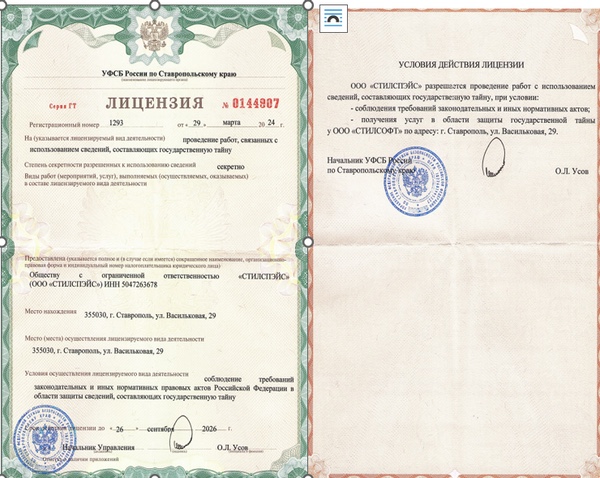 FSB license given to Stilspace. Source |
In the same presentation, Burmak went on to show some of the images made by Stilsat-1, including two with a possible connection to the war in Ukraine. One is a picture of the Rzeszow-Jasionka international airport in southeastern Poland, which has been used as a trans-shipment hub for weapons, medical aid, and other supplies to Ukraine. The other is a photograph of the Crimean Bridge, built after Russia’s annexation of Crimea in 2014 to connect the peninsula to the Russian mainland. The picture was taken on May 31, 2024, which according to Burmak was “after the [Ukrainian] attacks on it”, although none were reported at the time.
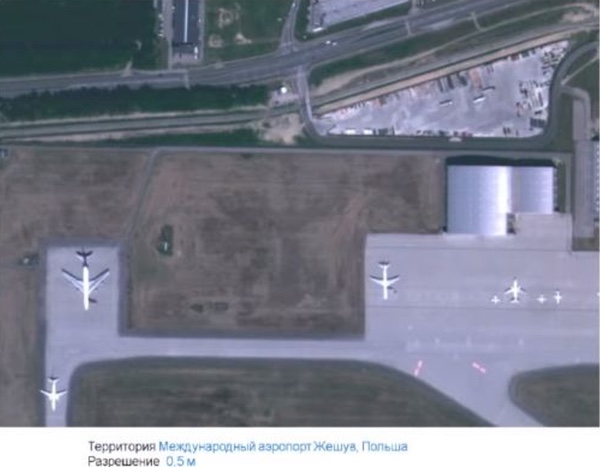 Stilsat-1 image of Rzeszow-Jasionka airport in Poland. Source |
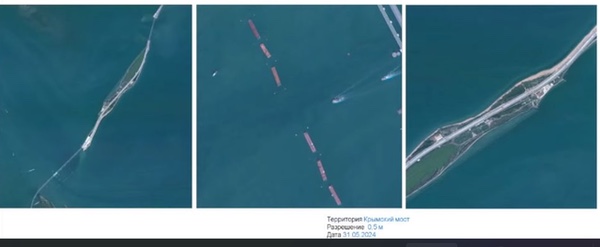 Stilsat-1 images of the Crimean Bridge. Source |
Stilsat-1 is not being used exclusively in the interests of the security agencies. Also seen in Burmak’s presentation were some of the civilian objectives of Stilsat. These include the monitoring of critical infrastructure and emergency situations, the search for new natural resources, environmental monitoring, and observations for agricultural and mapping purposes.
One key factor in the decision to purchase a Chinese satellite was the inability of the Russian industry to quickly deliver an advanced optical system with a resolution of 0.5 meters. This was, in fact, openly admitted by the governor of the Stavropol region when he briefly mentioned Stilsoft’s satellite plans to President Vladimir Putin during a meeting on December 5, 2023. [9] It was also acknowledged by Stilsoft director Yuri Stoyanov in an interview later that same month. [10] Speaking back in 2018, Stoyanov had stated that he was “scared” by the prospect of China becoming a global leader in high tech by 2025. [11]
The fact that the Russian-built versions of Stilsat will continue to use the Chinese high-resolution optical system may well raise some eyebrows in Russia’s optical industry. Russian optical systems with similar capabilities are expected to fly on several civilian remote sensing satellites in the coming years and may already be operational aboard military satellites.
Stilsat is unique compared to other Russian defense-related space projects in that a private company is operating a satellite in the interests of the country’s security agencies. This is a departure from the standard practice in which the Ministry of Defense assigns projects to prime contractors belonging to the Roscosmos State Corporation and then assumes control of the satellites after they are launched into orbit.
| Even though the Chinese connection of the Stilsat project hasn’t been kept secret, it hasn’t been widely publicized either. |
It does seem that Stilsoft itself does not provide the data directly to end users. In September 2023, it signed an agreement on data distribution with Terra Tech, a daughter company of Russian Space Systems, which is part of Roscosmos. Terra Tech was granted the exclusive right to distribute Stilsat data to government users. The deal was billed as the first example of such a partnership between the private industry and the government in the space domain. Commenting on the deal, Terra Tech’s director claimed it would make Russia “less dependent on foreign suppliers of remote sensing data,” ignoring the fact that the data would be gathered by a Chinese-built satellite [12].
Strangely enough, legislation allowing Roscosmos to sell remote sensing data from commercial operators to government users was approved by the Russian parliament only in April 2024 and went into effect in January 2025, well after the deal between Stilsoft and Terra Tech was concluded. [13] The legislation seems to have been introduced as part of a roadmap approved by the Russian government in December 2022 to forge closer ties between Russia’s private space sector and the government. However, Stilsoft was not among the companies that signed a letter of intent on participation in the roadmap the following month. [14]
When introducing Stilsoft’s presentation in June 2024, a Roscosmos official said that the Stilsat-1 mission was taking place outside the framework of the roadmap, without explaining why. The most likely reason is that the Stilsat-1 data were urgently needed to fill gaps in Russia’s satellite coverage of Ukraine. That would explain why Stilsoft and Terra Tech were given special permission to make arrangements on data distribution that were, in fact, not covered by existing legislation at the time. Whether organizations such as the Ministry of Defense and FSB actually pay for the Stilsat-1 data is another matter. Under the legislation passed in April 2024, commercial remote sensing data for the country’s “defense and security” will be forwarded to end users free of charge.
Even though the Chinese connection of the Stilsat project hasn’t been kept secret, it hasn’t been widely publicized either. Numerous sources (including the websites of Stilsoft and Stilspace) don’t mention it at all and others have done so only in passing. The acquisition of the Chinese satellite and the transfer of Chinese optical technology are obviously considered an inconvenient truth that should not attract too much media coverage.
Design of Stilsat
Over the past two years or so, Stilsoft and Stilspace have presented considerably different versions of Stilsat. The satellite originally seen on Stilspace’s website featured a slender bus with two solar panels and had no prominent optical system. Nevertheless, it was said to have a resolution of 0.5 meters in panchromatic mode and 1.5 meters in multispectral mode, with a swath width of 15 kilometers operating from an altitude of 500 kilometers. Weighing 250 kilograms, it was specifically identified as Stilsat-1 and was expected to be launched from the Vostochny cosmodrome in Russia’s Far East. The launch date was first given as 2023 and later as 2024. By early 2024 it disappeared from the website.
 Original version of Stilsat-1. Source: Stilspace. |
Аnother version of Stilsat-1 was displayed at several exhibitions in which Stilsoft took part between late 2023 and the middle of 2024. This one had a square-shaped body with a black lens hood sticking out from it.
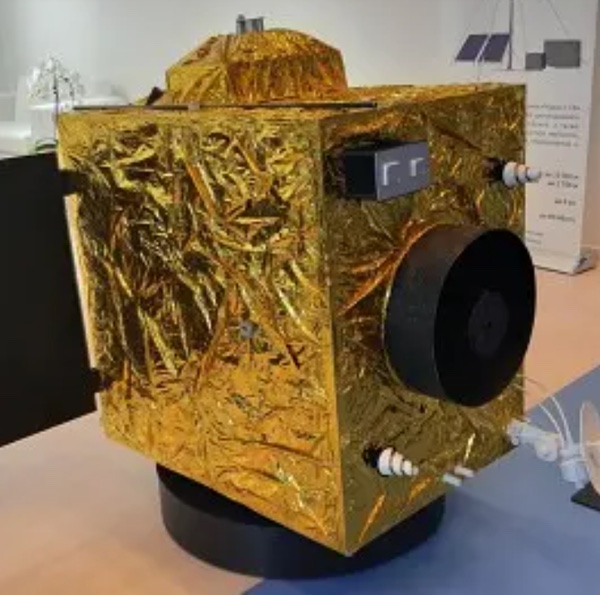 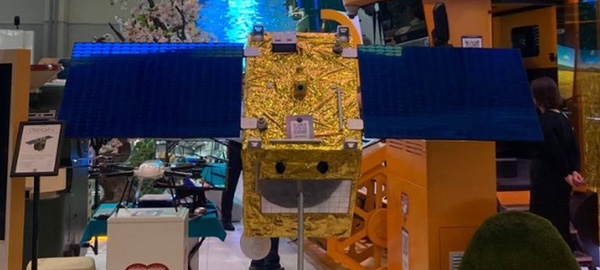  |
During presentations in October and November 2023, Stilsoft and Stilspace showed two Stilsat versions that again looked radically different. One, specifically named Stilsat-1 in one of the presentations, had a rectangular bus with two solar panels and a long remote sensing telescope attached to it. A similar design was also seen for some time on Stilspace’s website.
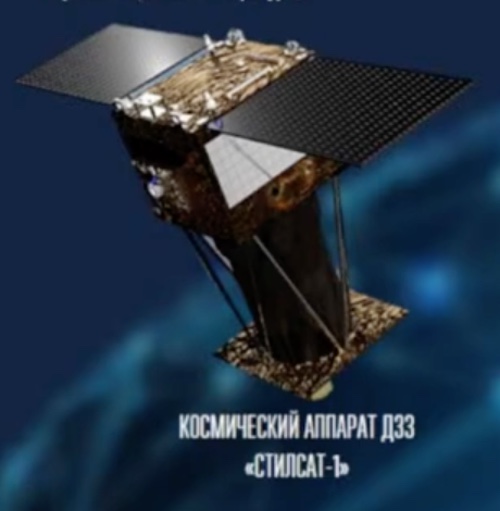 Illustration of Stilsat-1. Source |
 Similar looking Stilsat version seen on an old version of Stilspace’s website. |
The other, described in one of the presentations as the serially produced Russian version of Stilsat, looked somewhat similar, but had a hexagonal bus.
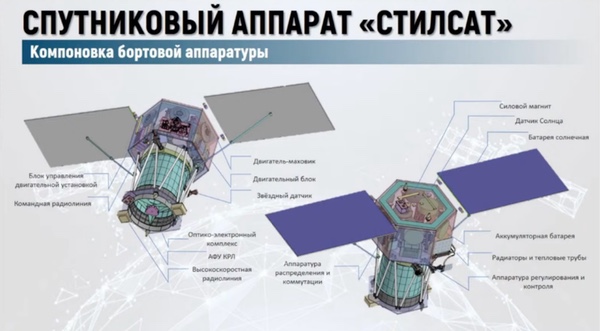 Russian-built version of Stilsat. Source |
The latest version, still seen on Stilspace’s website today, also has a hexagonal bus, but is equipped with three solar panels instead of two.
 Stilsat version currently seen on Stilspace’s website. |
The mass given for the satellites with the large optical payload has ranged from 270 to 420 kilograms, which may reflect differences between the satellite purchased from China and the ones that will be produced in Russia. They are designed to operate in Sun-synchronous orbits at an altitude of roughly 500 kilometers and have an expected operational lifetime of five years. The optical system has a resolution of 0.5 meters in panchromatic mode (with a spectral band of 0.45–0.70 microns) and 2 meters in multispectral mode (with spectral bands of 0.45–0.52, 0.52–0.59, 0.63–0.69, and 0.77–0.89 microns.) The swath width is 12 kilometers. One source gives a focal length of 7000 millimeters.
Identifying Stilsat-1
Although a satellite that Stilsoft calls Stilsat-1 is currently in orbit, the company has given conflicting information on its launch date and has not revealed its official Chinese name. This has caused confusion even within Russia’s own remote sensing industry. In a roundup of remote sensing missions launched in 2024, AO Rakurs, a leading Russian distributor of remote sensing data, noted that Stilsat-1 had been launched on an undisclosed date and in cooperation with an unnamed Chinese manufacturer. Therefore, the company concluded, it should be either listed as a Chinese remote sensing satellite or not included in the statistics for 2024 at all. [15]
One reporter writing for a Russian telecommunications website tried in vain to obtain more specific information from Stilspace while preparing a story on the project in August last year. He did learn from a source in the Russian remote sensing industry that Stilsat-1 could possibly be one of four identical satellites orbited by China on May 20, 2024, under the names Beijing-3C-01, 02, 03, and 04. [16]
Developed by the Twenty-First Century Aerospace Technology Company, these 285-kilogram satellites indeed have the same capabilities that have been reported for Stilsat-1 (a resolution of 0.5 meters in panchromatic mode and 2 meters in multispectral mode with a swath width of 12 kilometers from an altitude of 500 kilometers.) They also resemble the latest drawing of Stilsat seen on Stilspace’s website, namely a hexagonal bus with three solar panels and a remote sensing telescope protruding from it. Furthermore, May 2024 was mentioned as the anticipated launch date in a press release on the Stilsoft-Terra Tech deal in September 2023 and by Stilspace’s Anton Burmak during his presentation in October 2023. In a slide seen during Burmak’s June 2024 presentation, the launch date was given as “the second quarter of 2024”, even though Burmak did not actually confirm that.
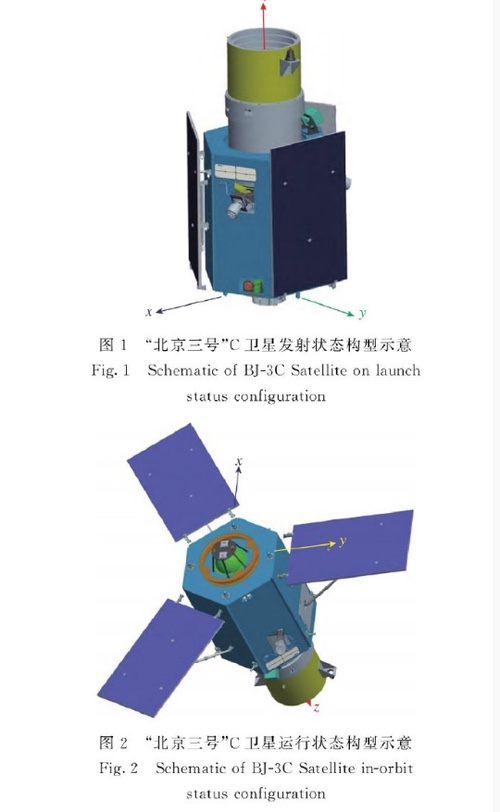 The Beijing-3C remote sensing satellite. Source |
Still, there are strong reasons to believe Stilsat-1 is not one of the Beijing-3C satellites. First, they are reported to operate as a constellation, with their orbits phased to maximize coverage of regions of interest. They also work in conjunction with Beijing-3A and Beijing-3B, two satellites launched in 2021 and 2022. This would make it difficult for Russia to operate one of them for its own specific needs. Second, the hexagonal bus with three solar panels is not seen in illustrations of Stilsat-1 published by Stilsoft. Third, there is ample evidence that Stilsat-1 went into orbit earlier in 2024.
The first sign that the launch was imminent came during the earlier mentioned meeting between Vladimir Putin and the governor of the Stavropol region (Vladimir Vladimirov) on December 5, 2023. Putin was told that the launch was expected before the end of the year. Then, on January 15, 2024, Stilspace issued a brief press release on its website indicating that the launch had taken place. It said that the first data from Stilsat-1 had made it possible “to count all the walruses on the coast of Bely island,” a big island off the coast of the Yamal peninsula in the Russian Arctic.[17]
| So far there is no definitive evidence that Taijing-3-02 is the satellite purchased by Russia under the name Stilsat-1. Nevertheless, there are some additional factors supporting this conclusion. |
Pictures made by the satellite began appearing on Stilspace’s website in the following weeks and, in early April, the company began offering Stilsat-1 imagery for sale (albeit not to the general public.) Pictures taken by Stilsat-1 as early as March 10, 2024, were shown during Burmak’s presentation on June 27, 2024, contradicting the information in one of the slides that the launch had taken place in the second quarter of the year. Finally, in a press release on a meeting between Russia’s Deputy Prime Minister Aleksandr Novak and a Stilsoft delegation on July 31, 2024, the company disclosed that Stilsat-1 had been “carrying out its duties in orbit” since January of that year. [18]
All that would put the launch date somewhere between January 1 and January 15, 2024, the date of Stilspace’s first press release on the Stilsat-1 mission. During that period, China conducted four space launches, but none of these placed into orbit a remote sensing satellite with capabilities corresponding to those announced for Stilsat-1. The only Chinese satellite launched in January 2024 that fits the bill is one announced as Taijing-3-02, one of five remote sensing satellites placed into orbit on January 23 by a Lijian-1 solid-fuel rocket from the Jiuquan Space Center in northwest China. This is one of several types of remote sensing satellites produced by a Chinese private firm called Beijing Weina Star Technology, also known as MinoSpace.
Little information was provided about the satellite by Chinese media after launch. It was reported to have a 0.5-meter resolution in panchromatic mode and a 2-meter resolution in multispectral mode from an altitude of 530 kilometers. The swath width was given as 10 kilometers. The satellite was said to be suitable for applications in a wide range of fields, including land and resource monitoring, geographic surveying and mapping, urban planning, detection of energy and mineral resources, and high-precision map production, all with high commercial value.
Among the pictures released of Taijing-3-02 are two in which the satellite sits atop a dispenser that also carries the four other, smaller satellites.
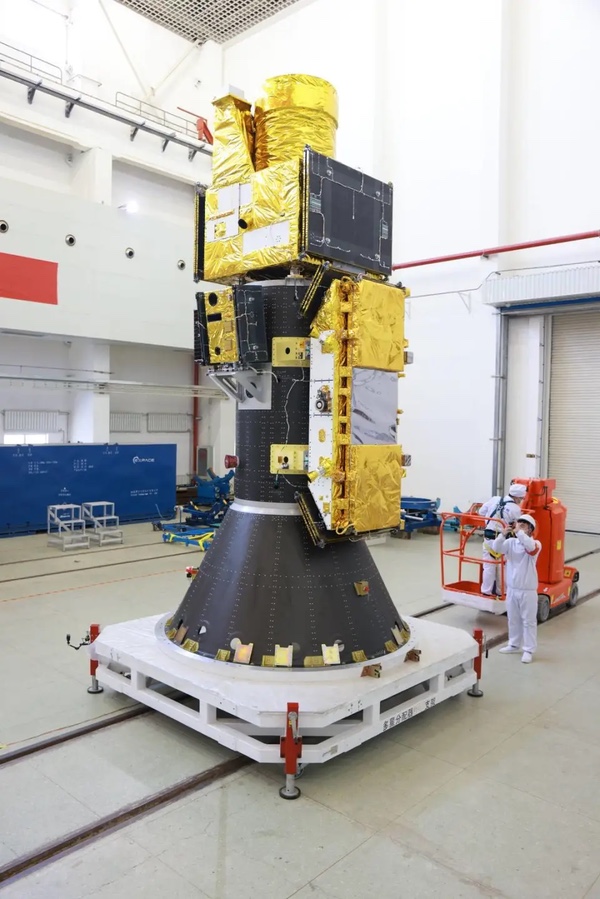  |
The satellite is also seen in footage of the launch aired by the CCTV 13 television channel (see the image heading this article), which also released some animation of the satellite in orbit.
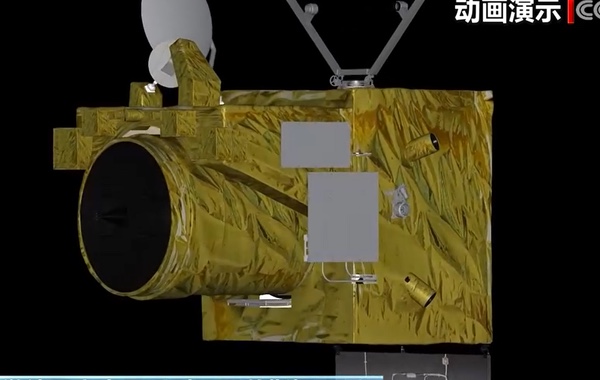  Two illustrations of Taijing-3-02 in orbit. Source |
Taijing-3-02 is most likely the object that was given the international designator 2024-016C and NORAD catalog number 58822. This is the only object from this launch with a large radar cross section and also the only one that has maneuvered. The satellite was launched into an orbit of 523x542 kilometers with an inclination of 97.52° and its orbit gradually decayed until it started a series of orbit-raising burns in late August this year. It is currently in an orbit of 488x504 kilometers and has two daylight passes over Ukraine every morning. The satellite’s bus, rectangular in shape with two solar panels, looks very similar to that of one of the Stilsat-1 versions presented in late 2023. However, the swath width is somewhat smaller than that given for Stilsat-1 (10 versus 12 kilometers) and there is an additional feature right next to the optical telescope that is not seen in the Stilsat-1 illustrations.
So far there is no definitive evidence that Taijing-3-02 is the satellite purchased by Russia under the name Stilsat-1. Nevertheless, there are some additional factors supporting this conclusion apart from the reported January 2024 launch date of Stilsat-1. First, MinoSpace has recently advertised itself as a company that offers “turnkey satellite solutions for small satellite missions,” including “ready-to-launch satellite platforms.” [19] At least two countries seem to have displayed interest in cooperating with the company. In August 2024, the Washington Post reported that Iran was seeking a business arrangement with MinoSpace to enhance its surveillance capabilities from space. [20] Iran had earlier purchased a remote sensing satellite from Russia. Launched under the name Khayyam in August 2022, it has a resolution of about 1 meter. Possibly, the country has been considering the option of acquiring a satellite with 0.5-meter resolution from MinoSpace.
Earlier this year, officials of Nigeria’s space agency held talks with MinoSpace on the possibility of using its submeter-resolution satellite technology. The agency is evaluating “the most suitable type of satellite platform to be co-developed with international partners like MinoSpace,” indicating it is considering to purchase a satellite from MinoSpace rather than just order imagery from it. [21] The least this shows is that MinoSpace has been promoting its satellite technology (including ready-to-use satellite platforms) on the international market. Russia may well have been the first foreign partner with which it managed to strike a deal.
Another notable fact is that Taijing-3-02 is the only satellite missing from a page on MinoSpace’s website with basic descriptions of all the satellites it has launched to date. [22] It is only mentioned in the website’s launch log, without any additional details being given. This could well be a sign that it is a foreign-owned satellite about which the company does not want to divulge any information.
| All this suggests that Stilsat-1 is a name that the Russians have been using for more than one satellite. |
The best evidence for a link between Stilsat and MinoSpace comes from a website run by ScanEx, a Moscow-based organization that operates a network of ground stations to pick up imagery from remote sensing satellites. ScanEx offers Stilsat imagery for sale on its website, even though there have been no reports of any marketing deals with Stilsoft. Stilsat-1 shows up in a list of remote sensing satellites for which ScanEx gives daily orbit updates. Here it has the international designator 2025-108B and NORAD catalog number 64088. [23] This is one of six payloads orbited by another Lijian-1 rocket from Jiuquan on May 21, 2025. The two main payloads were produced by MinoSpace, namely Taijing-3-04 (a 310-kilogram optical remote sensing satellite) and Taijing-4-02A (a 267-kilogram radar imaging satellite.) The US space catalog does not give satellite names to any of the six objects, but the fact that object B is the only one with a large radar cross section indicates it is Taijing-3-04. It is currently in an orbit of 510x530 kilometers with an inclination of 97.50° and its orbital plane is separated by only several degrees from that of Taijing-3-02. It is also worth noting that the launch date of Stilsat-1 has been updated on Stilspace’s website from the second quarter of 2024 to the second quarter of 2025.
All this suggests that Stilsat-1 is a name that the Russians have been using for more than one satellite. Although Taijing-3-02 would seem to be the satellite purchased by Russia for its own exclusive use, it is possible that Stilsoft made a deal to obtain imagery from other remote sensing satellites built by MinoSpace but operated by the Chinese themselves. Possibly, this deal went into effect in the beginning of 2024, explaining why Stilsoft announced the reception of the first Stilsat-1 data on January 15 of that year, a week before the launch of Taijing-3-02. That initial imagery could have been obtained by Taijing-3-01, launched on February 27, 2022. This was the first of MinoSpace’s high-resolution Earth imaging satellites based on a bus called MN-200, with Taijing-3-02 and Taijing-3-04 being the other two (there is no satellite called Taijing-3-03.)
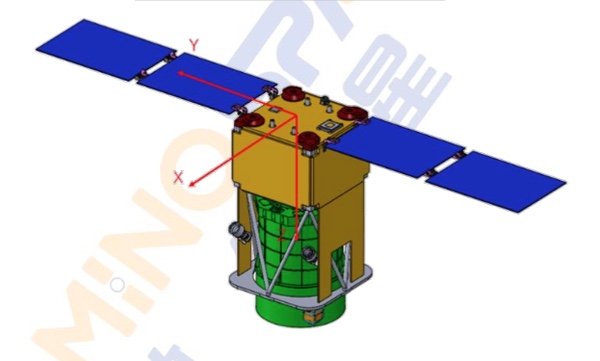 MinoSpace’s MN-200 bus. The payload is depicted without its surrounding thermal vacuum insulation. Source |
Although all three satellites have the same ground resolution (0.5 meters panchromatic and 2 meters multispectral), there are some differences between the payloads. Externally, the payload of Taijing-3-01 most closely resembles the one seen in the late 2023 Stilsat-1 illustration. It is described on MinoSpace’s website as a TDI-CCD three-mirror anastigmat pushbroom camera with a mass of 139 kilograms. The swath width is the same as that given for Stilsat-1 (12 kilometers from an altitude of 500 kilometers), but the focal length is somewhat larger (8800 versus 7000 millimeters.) The overall mass of the satellite (240 kilograms) is close to the lowest one reported for Stilsat (250 kilograms.)
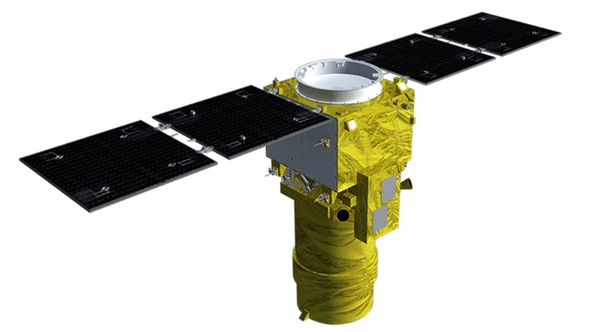 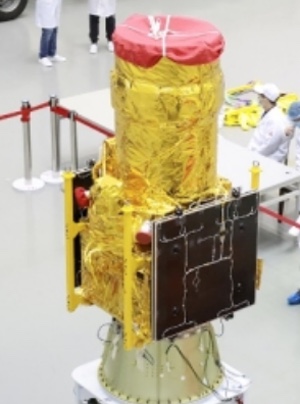 |
Taijing-3-04 is 70 kilograms heavier than Taijing-3-01 (310 versus 240 kilograms); no mass has been reported for Taijing-3-02. Like Taijing-3-02, it has an additional feature right next to the optical telescope, but it looks different. The payload has a swath width of 18 kilometers from an altitude of 500 kilometers and a significantly higher data download speed than that of Taijing-3-01 (900 versus 450 megabits per second.)
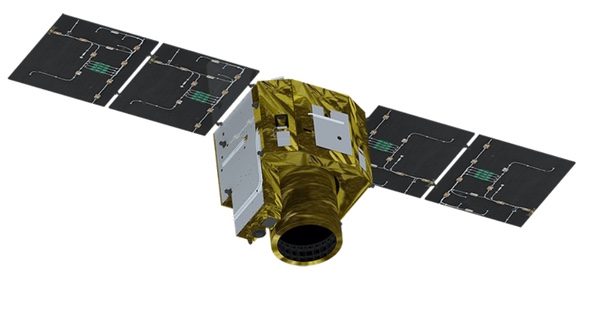   |
On its website, MinoSpace underlines that the camera payload for Taijing-3-04 was developed in-house, “significantly enhancing market economic efficiency.” Earlier optical payloads seem to have been designed and manufactured by what is identified on the website as the Changchun Optical Payload Center (AIT), based in the northern Chinese city of Changchun. Strangely enough, there are no traces of it elsewhere on the Internet.
Putting it all together, Stilsoft could be receiving high-resolution imagery from three Chinese-built satellites (Taijing-3-01, 3-02, and 3-04) that it refers to as Stilsat-1, one of which (presumably Taijing-3-02) was purchased by Russia and is being operated by the company itself. The three satellites seem to have slightly different optical systems, only one of which is likely to be inherited by the Russian-built versions of Stilsat.
To complicate matters even more, Stilsoft has also applied the name Stilsat-1 to what appear to be two smaller satellites with less sophisticated optical systems (see the section “Design of Stilsat”). The one with the slender bus was claimed to be intended for launch from Vostochny cosmodrome. Despite the fact that it was said to be a 250-kilogram high-resolution satellite, it is externally reminiscent of a 6U cubesat, including one type built by MinoSpace (the MN6U platform). This was launched three times in 2018–2019 on remote sensing missions with a resolution of no higher than 10 meters.
 MinoSpace’s MN6U platform. Source |
One remote possibility is that Stilsoft had ordered such a 6U cubesat from MinoSpace to be launched as a piggyback payload on a Soyuz-2 rocket from Vostochny. In late 2023, when Stilsoft reported Stilsat-1 was planned for launch in May 2024, a Soyuz-2 rocket was scheduled for launch from Vostochny that month with the two first Ionosfera-M scientific satellites and a large amount of rideshare payloads. The mission eventually slipped to November 2024 and deployed several 6U cubesats into roughly 500-kilometer Sun-synchronous orbits, but none belonged to Stilsoft. If such a satellite had indeed been planned for launch on that mission, it had vanished from the payload manifest by that time. Another possible candidate is an unidentified 6U cubesat launched on a test flight of the Angara-A5 rocket from Vostochny on April 11, 2024. However, this was deployed into a very low orbit and re-entered after less than two weeks. [24]
The square-shaped satellite displayed by Stilspace under the name Stilsat-1 cannot be matched to any known satellites. At this point, there are two possible explanations for these versions of Stilsat-1. One is that one or more much smaller satellites going by this name were indeed planned for launch. This could also explain why Stilspace earlier offered imagery with a resolution of down to 30 meters on its website. Another is that Stilsoft made a deliberate effort to obfuscate the true design and heritage of Stilsat-1.
References
- Website of Stilsoft.
- Interview with Yuri Stoyanov, 2018.
- Sanctions list of the US State Department, November 2, 2023.
- Article in the Kyiv Post, July 26, 2025 (includes videos of the drone attacks).
- Website of Stilspace.
- Video of presentation by Yuri Stoyanov (5:42:55-5:56:00), November 23, 2023.
- Video and PowerPoint of presentation by Anton Burmak, October 2023.
- Video of presentation by Anton Burmak (1:49:15-2:05:15), June 27, 2024.
- Transcript of a meeting between Vladimir Putin and the governor of the Stavropol region Vladimir Vladimorov on the Kremlin website, December 5, 2023.
- Interview with Yuri Stoyanov, December 12, 2023 (website blocked outside Russia).
- See reference 2.
- Press release on the website of Terra Tech, September 26, 2023. Stilsat-1 images are offered for sale by Terra Tech on this page. It is described here as “a commercial Russian satellite”.
- The text of the legislation can be found here.
- Announcement by the Russian government, January 16, 2023
- Overview of remote sensing satellites launched in 2024, published by AO Rakurs.
- Article on the website of Comnews, August 26, 2024.
- News item on the Stilspace website, January 15, 2024.
- News item on the Stilsoft website, August 1, 2024.
- MinoSpace LinkedIn page.
- Article in the Washington Post, August 16, 2024.
- Article on SpaceWatch Africa, June 23, 2025.
- Website of MinoSpace.
- Page on a ScanEx website with Two-Line Elements of remote sensing satellites. ScanEx offers Stilsat imagery for sale here.
- Although the presence of the 6U cubesat was announced by the manufacturer of the cubesat dispenser, the satellite was not named or registered with the United Nations. It must have been one of two objects catalogued by the US as 2024-069C and 2024-069D.
Note: we are now moderating comments. There will be a delay in posting comments and no guarantee that all submitted comments will be posted.
